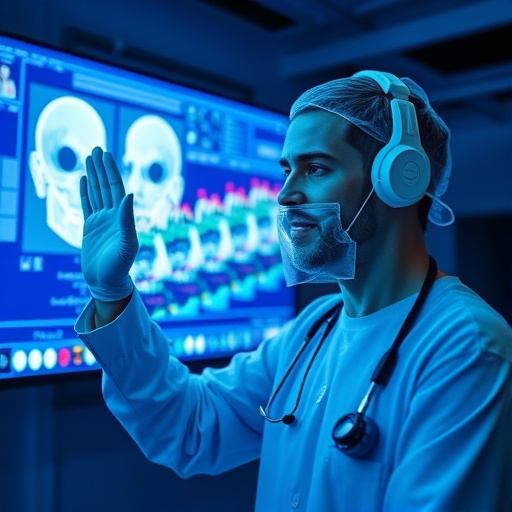In the rapidly evolving landscape of health care education, immersive technologies such as virtual reality (VR), augmented reality (AR), and mixed reality (MR)—collectively known as extended reality (XR)—are transforming traditional training paradigms. Spearheaded by a comprehensive national study from George Mason University’s Lab for Immersive Technologies, this research offers an unprecedented examination of XR’s efficacy in fostering advanced clinical skills and knowledge among health care professionals. By synthesizing findings from over 100 empirical studies, the investigation delineates both the immense potential and the technical complexities that accompany the integration of XR into medical and nursing education.
At the core of XR-based simulation is the ability to immerse students in lifelike clinical scenarios that are difficult or impossible to replicate through conventional methods. These scenarios include tasks such as intravenous line insertion, patient communication, skin examination, and pediatric emergency triage. Unlike mannequins or standardized patients, XR environments dynamically present multi-sensory inputs and interactive elements within three-dimensional virtual spaces. The nuanced simulation of patient physiology and pathology allows learners to acquire procedural competencies and crisis management skills in a risk-free, repeatable manner, accelerating skill acquisition and confidence.
Crucially, XR also expands access to rare or complex clinical experiences that would otherwise be unavailable due to logistical, ethical, or safety concerns. For example, mass-casualty incident response, interprofessional collaboration, and high-acuity emergency care can be reproduced virtually, offering learners vital exposure to high-stakes situations. This capability represents a paradigm shift in medical education, as it democratizes experience opportunities and enriches curricula with scenarios tailored to evolving health care demands.
However, the study emphasizes that successful implementation of XR requires meticulous instructional design grounded in cognitive science principles. Excessive sensory stimuli and poorly calibrated immersive environments risk cognitive overload, which undermines learning efficacy. Additionally, technical limitations such as avatar realism, haptic feedback fidelity, and latency issues can detract from the sense of presence and user engagement. Motion sickness and ergonomics of head-mounted displays remain notable barriers affecting a subset of learners, requiring adaptive hardware and software solutions.
Privacy and data security concerns also arise in XR settings, particularly as platforms collect detailed behavioral and biometric data for performance analytics. Ensuring compliance with health privacy regulations and institutional review standards is imperative to maintain learner confidentiality and trust. Beyond infrastructure, the integration of XR into health education demands robust faculty training and dedicated technical support teams capable of troubleshooting complex simulations and maintaining evolving software ecosystems. Sustainable funding models are necessary to accommodate the rapid iterative development cycle characteristic of immersive technologies.
While preliminary outcomes demonstrate promising effects of XR on learner engagement, skill retention, and collaboration, the literature reveals a conspicuous absence of longitudinal data connecting XR-based learning to tangible clinical performance and patient outcomes. More rigorous, controlled studies investigating transfer validity—the extent to which skills acquired in virtual environments translate to real-world competence—are a pressing need. Such evidence is critical for policy makers and accreditation bodies considering mandatory incorporation of XR in health care curricula.
The future trajectory for XR in health professions education is tightly intertwined with advancements in artificial intelligence (AI) and haptic technology. AI-driven adaptive simulations can customize scenarios in real time based on learner performance metrics, thereby optimizing cognitive load and promoting mastery learning. Meanwhile, sophisticated haptic devices promise to replicate tactile sensations such as texture, resistance, and weight, significantly enhancing realism and procedural fidelity. Additionally, development of more lightweight, wireless, and ergonomically designed headsets will mitigate current usability challenges and increase accessibility.
Experts involved in the study underscore the importance of intentional deployment of XR tools — not merely for novelty but strategically aligned with pedagogical objectives. When thoughtfully integrated, XR can revolutionize knowledge retention, procedural skill development, and interdisciplinary communication. These immersive platforms offer unprecedented opportunities for rehearsing critical thinking and decision-making in contexts that mirror the complexities of modern health care environments.
The full scope of this research, titled “Extended Reality in Health Care Simulation: Current State, Challenges, and Future Directions,” is featured in the October 2025 edition of Nurse Educator. The article presents a thorough analysis valuable to educators, technologists, and administrators aiming to harness immersive technologies to enhance training efficacy and ultimately improve patient care outcomes. This publication also serves as a roadmap, identifying critical gaps and future directions for research and development in this promising field.
As XR technologies continue to mature, their impact will extend beyond initial training into continuing professional development, competency assessment, and interprofessional education. The iterative feedback loops enabled by immersive analytics will empower educators to continuously refine curricula and tailor learning experiences to diverse learner needs. With careful stewardship, XR stands poised to become a cornerstone in the transformation of health care education, bridging theoretical knowledge and clinical practice with unprecedented fidelity and personalization.
In summary, George Mason University’s landmark study confirms that while extended reality holds transformative promise for health care training, realizing its full potential depends on overcoming significant design, technical, and educational challenges. Future innovations driven by AI and haptics, combined with empirical validation of transfer effectiveness, will determine how deeply XR reshapes the landscape of medical education and patient safety.
Subject of Research: Extended reality (XR) technologies in health care education
Article Title: George Mason-led study highlights how XR is reshaping health care training across the country
News Publication Date: 15-Oct-2025
Web References:
https://journals.lww.com/nurseeducatoronline/fulltext/9900/extended_reality_in_health_care_simulation_.811.aspx
http://dx.doi.org/10.1097/NNE.0000000000001996
Image Credits: Photo by George Mason University
Keywords: Virtual reality, Education technology, Educational methods, Education research, Learning, Education




